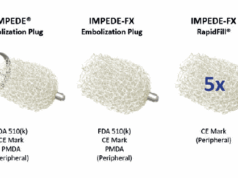
Shape Memory Medical recently announced that the US Food and Drug Administration (FDA) has granted investigational device exemption (IDE) for the company to begin a prospective, multicentre, randomised, open-label trial to determine safety and effectiveness of the Impede-FX RapidFill device to improve abdominal aortic aneurysm (AAA) sac behavior when used with elective endovascular aneurysm repair (EVAR).
“Securing a first-round FDA approval for AAA-SHAPE marks a significant milestone in the clinical development of the novel shape memory polymer technology for treatment of aortic aneurysms,” said Ted Ruppel, president and chief executive officer of Shape Memory Medical. “Large studies report that 60% of aneurysms fail to regress or expand within one year following EVAR, a problem linked to rehospitalisations, secondary interventions, and increased mortality. AAA-SHAPE will directly compare EVAR plus sac management with Impede-FX RapidFill to stand-alone EVAR to determine whether shape memory polymer improves patient outcomes post-EVAR.”
A press release details that AAA-SHAPE (Abdominal aortic aneurysm sac healing and prevention of expansion) will enrol 180 patients with infrarenal AAAs across 40 sites in the USA, Europe, and New Zealand. Study participants will be randomised 2:1, either to EVAR plus sac management with Impede-FX RapidFill (the treatment arm) or to standard EVAR (the control arm). Key endpoints will compare sac diameter and volume change, endoleak rates, secondary interventions, and mortality through five years.
The investigational device, Impede-FX RapidFill, incorporates the novel shape memory polymer, a proprietary, porous, polyurethane scaffold that is crimped for catheter delivery and self-expands upon contact with blood. In AAA-SHAPE, Impede-FX RapidFill is intended to fill the aneurysm blood lumen around a commercially-available EVAR stent graft to promote aneurysm thrombosis and sac shrinkage.
The AAA-SHAPE pivotal trial is preceded by the AAA-SHAPE early feasibility studies which enrolled a combined 35 patients in New Zealand and The Netherlands. This early experience was recently described by Andrew Holden et al in the Journal of Vascular Surgery: Cases, Innovations, and Techniques.
“The AAA-SHAPE early feasibility studies have been key to validating the procedural techniques and best practices that we will leverage in the pivotal trial,” said Marc Schermerhorn, chief of Vascular and Endovascular Surgery, Beth Israel Deaconess Medical Center (Boston, USA) and principal investigator of the AAA-SHAPE pivotal trial. “We are excited to initiate this widely-anticipated trial in the USA and abroad.”
Joining Schermerhorn as co-principal investigators are Virendra Patel, chief of Vascular Surgery, New York Presbyterian/Columbia University Irving Medical Center (New York, USA) and Ross Milner, chief, Section of Vascular Surgery and Endovascular Therapy, University of Chicago Medicine (Chicago, USA).
“We used to consider both aneurysm regression and stability as indicators of a successful EVAR outcome. However, contemporary data reveals that stable sacs are not as benign as once thought and that any failure of the sac to regress is associated with higher long-term mortality,” said Patel. “Shape memory polymer is a meaningful advancement in AAA repair and has the potential to address these unmet needs.”
Milner added: “I commend [Shape Memory Medical] on the decision to pursue a randomised controlled trial. This head-to-head study will offer the level 1 evidence the vascular community will seek to determine the potential role of shape memory polymer in the management of AAA patients.”














Hello.. This article proves that many EVAR operations fail due to the lack of clotting in the remaining part of the aneurysm around the indograft.(as I always say)